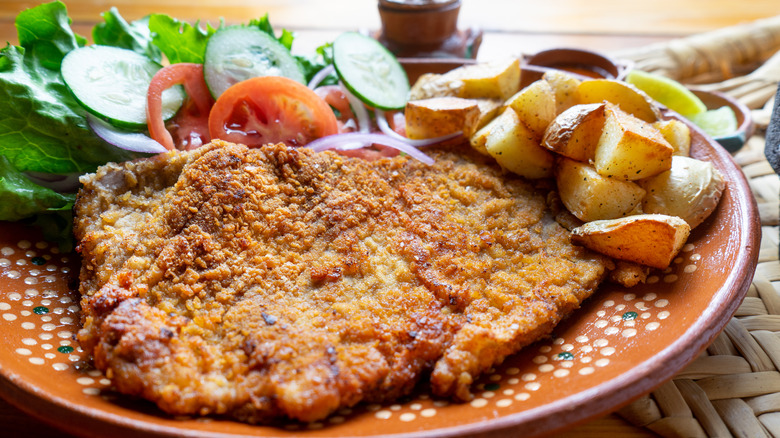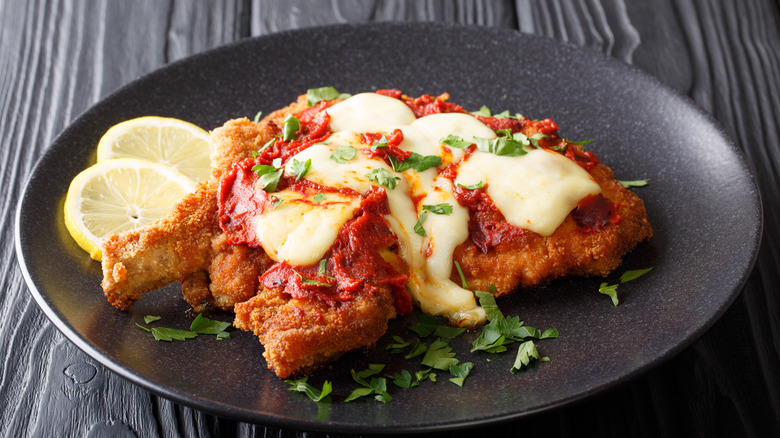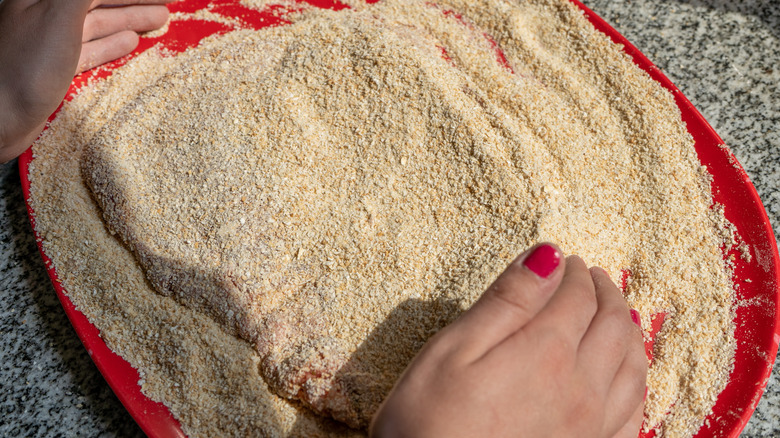Steak Milanesa Is The Unique Dish With A Crunchy Breadcrumb Coating
Some foods hit the right notes of simplicity, nostalgia and flavor. Whether it's a grilled cheese, loaded bowl of congee, or a chicken potpie, comfort foods can take on a range of forms. In Italy and Latin America — especially Argentina — a popular beloved food is the steak milanesa. Made with a thin cut of beef coated in breadcrumbs and pan-fried to golden, crispy perfection it's a dish with an appeal that is immediate.
The dish has longstanding popularity as it's well-seasoned, texturally intriguing, and easy to pair with other ingredients, like a ham and cheese topping. In fact, Argentina gave steak milanesa its own holiday — May 3. The dish is an affordable food that's enjoyed in cantinas, stuffed into sandwiches, and sold pre-prepped. Inside the home, it's not an intimidating endeavor, using straightforward techniques and commonly found ingredients. The combination of accessibility and delicious taste yields a truly special dish.
The background of steak milanesa
The easy-to-love appeal of a breaded steak has been around for a long time — first mentions of the dish trace back to 1134. As visible in its name, the dish hails from the Milan area of Northern Italy. The technique later spread to Austria, creating their beloved interpretation now called schnitzel. While the dish is still enjoyed in Italy, it's now become especially iconic in Argentina. Waves of Italian immigrants from the end of the 19th century onward carried the technique to the South American nation. And with the penchant for all things beef, the dish caught on.
While traditional Italian-style milanesa typically only employs tenderloin, in Argentina, preparations expanded to other cuts in addition to chicken and eggplant interpretations. The plate-sized breaded steak is often topped with ham, cheese, and tomato, and is served with fries. Steak milanesa is also a popular food in Mexico, where it's prepared as a filling for tortas, and served from street food stalls. Other renditions are also commonly enjoyed elsewhere in South America, with varying regional deviations.
How to make steak milanesa
With preparations in many Latin American countries, it's no surprise steak milanesa is made in a variety of ways. Regardless of the origins, the recipe still takes on a similar format. A steak is pounded to a very thin consistency — approximately ⅛ to ¼ thick — then coated in breadcrumbs, some flavorings, and eggs. Many beef cuts are utilized for the task, with some already purchased thin, while others pounded by hand. Common cuts include wide, relatively lean meats from the leg (such as top round and eye of round) or cuts from the shoulder. In Argentina, the selection is even more expansive and encompasses thicker varieties like flank or rump steak.
Seasonings differ, too. Mexican steak milanesa typically incorporates garlic and lemon with classic breadcrumbs or even saltines. Alternatively, Argentine steak milanesa throws mustard and parsley into the mix. Regardless of the seasonings, the assembly process is straightforward. After coating the meat in spices and breading, the steak is fried in a pan with a generous pouring of oil. Enough is used to coat the food to almost resemble deep-frying, creating a comforting bite of crispy perfection.


